
Though Bissell has been making upright wet and dry vacuums for years, the $399.99 the SpinWave Wet and Dry is its first robot that can do double duty. It’s a solid vacuum that reliably sucks up debris from low-pile carpeting and hard floors, and it truly shines when it comes to mopping, with two spinning microfiber pads and support for several different cleaning solutions to scrub away dirt and keep your floors looking as good as new. Plus, it can automatically detect and avoid carpeting and area rugs when mopping, a feature typically only seen on much more expensive models. It lacks home mapping abilities and voice control support, but it offers better performance than any other 2-in-1 robots in this price range, earning it our Editors’ Choice award.
SpinWave Wet and Dry Features
The SpinWave measures 12.25 inches in diameter and stands 3.25 inches tall, a fairly standard size for robot vacuums. It’s one of the more attractive models I’ve seen—I’m partial to its all-white design, as it matches my home decor much better than most robot vacuums, which are generally black, blue, or gray.
Adding to the sleek aesthetics is an attractive light ring circling the top, which indicates the robot’s status. When charging, the light ring will pulse once, then "breathe" (pulse slowly) for 30 seconds before turning off. A smaller light on the Start/Pause button will breathe the whole time the robot is charging. When the robot is fully charged, the Start/Pause button will shine solid.
The robot comes with a dry tank for vacuuming and a tank for mopping. The wet tank features two circular mop pads on the bottom that spin to scrub hard floors with a cleaning solution or just plain water. Bissell makes several different solutions you can use when mopping, including multi-surface, pet multi-surface with Febreze, and sanitizing formulas.

Bissell says to only use its brand of cleaning solutions, as other formulas can harm the robot and void the warranty. In the box with the SpinWave, you get an 8-ounce bottle of multi-surface floor cleaner, an extra set of reusable mop pads and edge-cleaning brushes, and an extra dustbin filter. The company sells 32-ounce bottles of cleaning solution starting at $9.99.
Most other robot mops and 2-in-1s, including the $799.99 Ecovacs Deebot Ozmo T8 AIVI, only support water, and aren’t recommended for use with cleaning solutions. The $499 iRobot Braava Jet m6 works with cleaning solution, but iRobot only offers one formula, and it doesn’t double as a vacuum.
Controlling the SpinWave
Bissell says to set up the charging dock at least 40 inches away from objects on either side, and 40 inches across from anything. Once you have the charging dock in place and plugged in, put the robot on the floor, turn it on using the switch on the side, and put it on the docking station. The first charge takes four to five hours.
While waiting for it to charge, you can download and connect the robot to its companion app so you can control it from your phone. The SpinWave doesn’t come with a separate remote control, so you’ll need to use the app to take advantage of all of its modes and features.
The setup process is simple. Just download the Bissell Connect app (available for Android and iOS) and sign in or create a new account. The app first asks a few questions, like what type of mess-makers you have in your home (dogs, cats, kids, and/or other), what needs to be cleaned (bare floor, carpet, stairs, upholstery, and/or car/garage), and what features are important to you (allergen control, eco-friendly cleaning, and/or lightweight products).

From there, it walks you through the setup process. Press Get Started, select the SpinWave Robot from the list, turn it on if you haven’t already done so, and press OK. The app then instructs you to locate a QR code under the dustbin and scan it with your phone to start the pairing process.
To turn on the SpinWave’s Wi-Fi, simply power cycle the device using the side switch, then hold the start/pause button for five seconds until you hear a beep. A pop-up then asks you to join the SpinWave’s Wi-Fi; accept this request, then enter your home Wi-Fi password to connect the robot to your network, and it will finish pairing. For me, this process only took a couple of minutes.
It’s worth mentioning that at one point in testing, the robot experienced a connectivity issue and wouldn’t work with the app. I had to remove it from the app, then go through the setup process again, after which it worked fine.
Using the app, you can change the robot’s cleaning pattern (Auto or Spot); select the suction power or water flow level (Low, Mid, Max); remotely start, stop, or pause it; send it back to its base station; schedule cleanings; view notifications; track your cleaning history; and troubleshoot errors. When creating a schedule, you can select the day, time, and suction power or water flow level. At the scheduled time, the robot will either vacuum or mop, depending on whether you have the dry or wet tank installed.
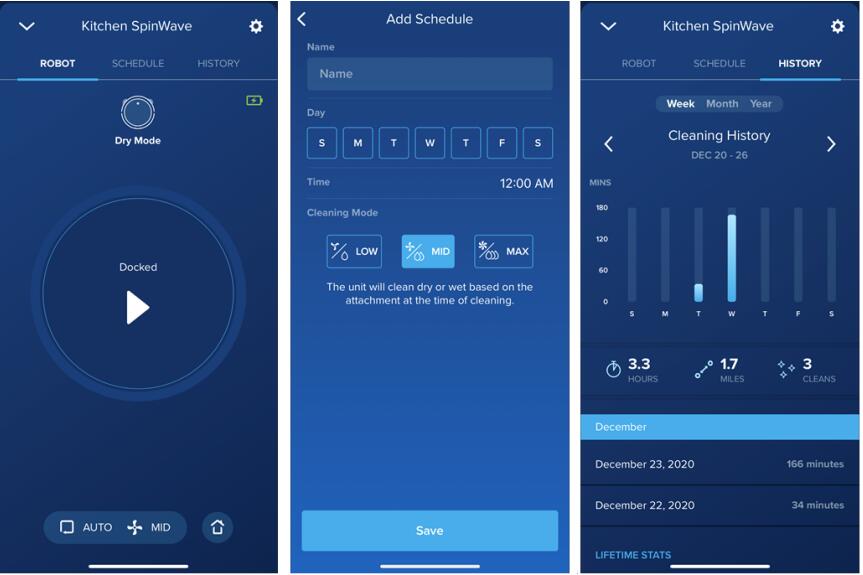
In the cleaning history section, you can view the date and duration of each session. The app also keeps track of lifetime stats such as distance, duration, and total number of cleaning jobs.
Given that high-end floor-cleaning robots can cost upward of $1,000, you can’t expect a $399.99 model to include every feature under the sun, and the SpinWave doesn’t offer home mapping or voice assistant support. Higher-end hybrids such as the $749 Roborock S6 MaxV can map your home and let you create virtual no-go zones. The S6 MaxV and many others also feature Amazon Alexa, Apple Siri, and Google Assistant support, so you can start and stop cleaning jobs with just your voice.
Vacuuming and Mopping With the SpinWave
In vacuuming mode, the SpinWave offers up to 1,500Pa of suction power, which allows it to easily collect pet hair, dust, and other debris from low-pile carpet and area rugs, as well as hard floors. If you mostly have carpeting in your home, especially if it’s medium- to high-pile, you will probably be better served by a robot with higher suction power, such as the $499 Proscenic M7 Pro (2,600Pa).
Like most other robot vacuums, the SpinWave features a main brush roll on the bottom, plus dual edge-cleaning brushes.

In Auto mode, the robot cleans in straight lines, and automatically returns to its dock when its battery runs low. In Spot mode, the robot cleans in a spiral pattern, covering an approximately 40-by-40-inch area for five minutes.
Bissell’s official battery life estimate is up to 100 minutes, which is pretty good, but not outstanding. On its first test run, the SpinWave vacuumed for 77 minutes on Auto before its battery ran low and it successfully navigated back to its docking station. On a subsequent test, it ran for an impressive 166 minutes, though it got wedged under my TV stand and required my help getting out. (When it gets into an issue like this where it needs assistance, the robot will beep loudly to let you know.) I believe the 166-minute result was an anomaly, and the robot may not have been actually cleaning the entire time, as it picked up about the same amount of debris in 77 minutes as it did in 166 minutes. After both of those sessions, the SpinWave’s 13.5-ounce dustbin contained a fair amount of dog hair and dust, but it wasn’t nearly full.
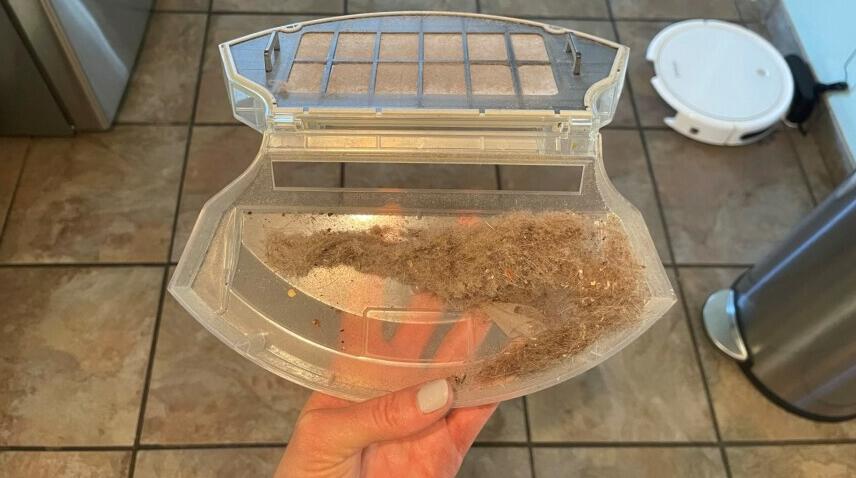
If you’re looking for a hybrid robot with exceptional battery life, check out the Deebot Ozmo T8 AIVI, which lasted 170 minutes—longer than any other robot vacuum we’ve tested. It also features artificial intelligence technology that allows it to automatically identify and avoid obstacles, so it rarely if ever gets stuck, though it also costs twice as much as the SpinWave.
While it works just fine as a vacuum, the SpinWave excels as a mop. While mopping, the SpinWave simultaneously sweeps, collecting a limited amount of dry debris. But for the best results, you should run it as a vacuum first before sending it out to mop.
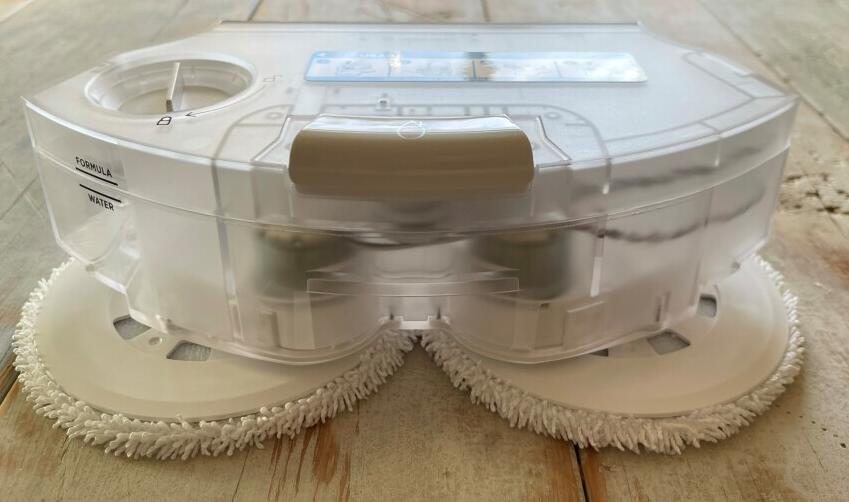
To fill up the mopping tank, you simply twist the cap to the unlocked position and remove it. There are two lines on the side of the tank, one marked Water, and one marked Formula. First, fill the tank with water to the Water line, then add a small amount of Bissell solution until you reach the Formula line. Then twist the mop tank cap back into place, and slide the tank into the robot.
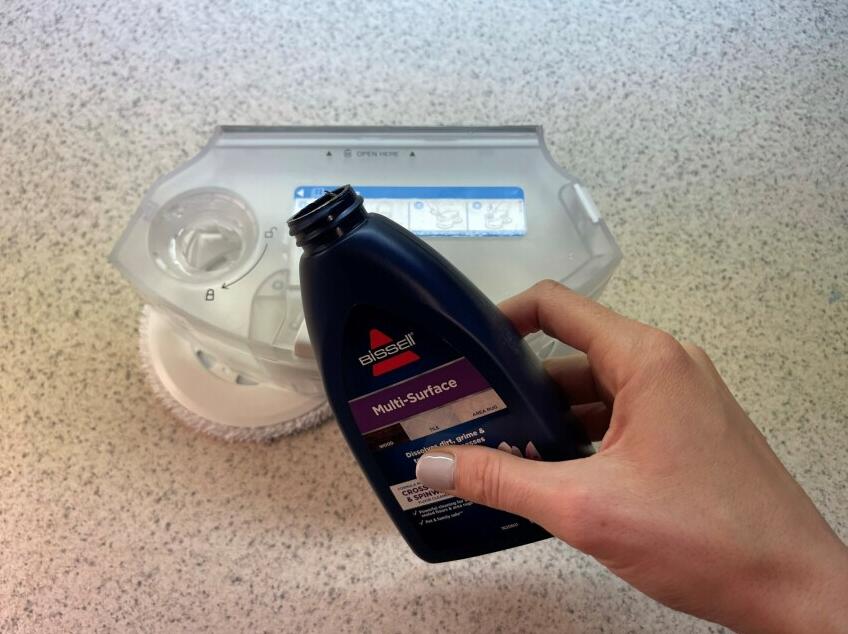
One of the things I like about the SpinWave is that it automatically detects and avoids carpet in mopping mode. When it reached the edge of an area rug in testing, it simply turned around in the other direction. This is an useful feature, and surprisingly rare—the only other robot mop I’ve tested with this ability is the Deebot Ozmo T8 AIVI. Some, like the $500 Proscenic M7 Pro, let you create virtual boundaries so they avoid certain areas when mopping, but it can be difficult cordoning off area rugs using this method. No-frills models like the Yeedi K700 offer no such features, and their manufacturers instead recommend folding the edges of area rugs under themselves to prevent robots from rolling over them while mopping, which isn’t a great solution.
Thanks to its multi-surface cleaning formula and dual spinning pads, the SpinWave left my floors shinier after a single pass than any other floor-cleaning robot I’ve tested. Other robots that mop with just water and a motionless pad tend to leave streaks and take a couple runs to get your floors shiny. The SpinWave achieved that result in just one pass, leaving both the laminate in my living and dining room and the tile in my kitchen looking clean and streak-free. As an added bonus, the multi-surface cleaning solution smells good.
In mopping mode, the SpinWave cleaned for 81 minutes, after which its pads were filled with grime.
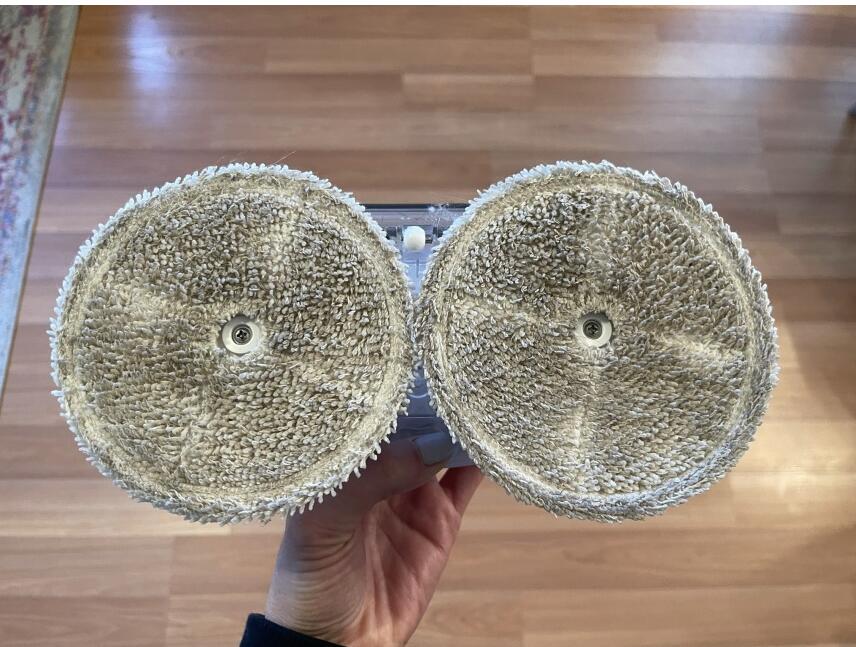
Toward the end of the job, the SpinWave got stuck on the transition strip between my living room and kitchen floors, but I simply used my foot to nudge the robot and set it free, then it returned to its dock without incident. When you’re done mopping, you can simply remove the pads from the bottom of the wet tank, and throw them in the hamper or washing machine.
Most of the time, you’ll probably run it in Auto mode so it mops everywhere, but Bissell recommends using Spot mode with its sanitizing formula to clean up concentrated messes, like pet accidents. To do this, simply place the robot in the center of the area you want to clean, then select Spot mode in the app. Your floor will likely be wet and slippery after running the SpinWave in Spot mode, so use caution until it dries.
Another of the SpinWave’s strengths is its low volume. When vacuuming and mopping, it’s quieter than a lot of other models I’ve tested. I had it running while I was on a Zoom call, for instance, and it didn’t disrupt me.
Like most floor-cleaning robots, the SpinWave requires regular maintenance, which includes emptying and washing the dustbin after every few sessions, and periodically cleaning the brush roll and caster wheel. You’ll also need to occasionally clean the edge brushes, or replace them altogether, to maintain optimal performance. Bissell offers maintenance instructions in the SpinWave manual, and how-to videos in its app.
It’s easy to empty the dustbin, but doing so exposes you to dust and other allergens. If you suffer from allergies, I suggest opting for a robot with automatic bin-emptying abilities, such as the $599.99 Roomba i3+. If you’re in search of a hybrid model with auto-emptying abilities, check out the Deebot Ozmo T8 AIVI or the Proscenic M7 Pro. Neither of them come with an automatic dust collector, but you can purchase one separately for $249.99 or $100, respectively.

